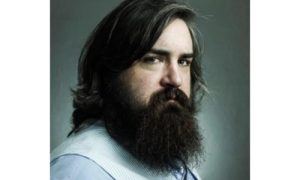
Like most people, there are plenty of moments from my youth that I look back on and cringe so hard that my body involuntarily curls up like a salad shrimp.
For example, I was thinking the other day about an incident in high school. I was talking to a friend of mine and I told him that I’d recently been to Radio Shack. For some reason, I said, the manager kept surreptitiously following me around like he thought I was going to steal something.
“Yeah, that happens to me all the time,” my friend said.
“Really?” I said. I was shocked. I had assumed I was followed because I looked scruffy, but my friend was one of the most clean-cut people I knew.
“Well, yeah,” my friend said. “I’m black.”
“Oh,” I said.
A few years after that, I was in a restaurant that used to be on the outskirts of Patrick County. I was playing pinball when I noticed a little framed black-and-white photo hanging next to the pinball machine. I leaned in and saw it was a photo from the 1925 Ku Klux Klan parade in Washington, D.C., in which 30,000 robed racists walked proudly through our nation’s capital.
I was stunned. How had I never noticed this before? I started looking around the restaurant, and suddenly I noticed things I’d never paid attention to before. There was a Confederate battle flag hanging on the wall, Hank Williams Jr.’s smiling face printed in the center of it, surrounded by text that read “If the South would’ve won, we would’ve had it made.” There were multiple “We reserve the right to refuse service to anyone” signs hanging all over the restaurant.
I felt like Rowdy Roddy Piper in “They Live” after he puts on the magic sunglasses that allow him to see the world as it really is. How many times had I gone to that restaurant without ever realizing the owners were enormous racists? There’s regular racism, and then there’s “hanging a photo of a Klan rally next to the pinball machine” racism. How had I been so blind?
A few years after that, I was working at a movie theater. My boss was black. We were standing on the stoop in front of the theater after work one evening, just shooting the breeze. My boss was wearing a suit; he was always a sharp dresser. I was wearing jeans and a T-shirt that probably had a picture of a wizard on it.
A police cruiser drove past the theater. It circled the block and looped back around, slowing down a bit this time. The third time it circled the block, the officer wasn’t even trying to hide the fact that he was staring down my boss and ignoring me completely. My boss shook his head.
“Happens all the time,” he said.
“If he makes a fourth pass,” I said, “I’m gonna pretend to mug you and blow his mind.”
He laughed, but there wasn’t much humor in it.
I’ve been thinking about incidents like these in the wake of the controversial music video for Jason Aldean’s song “Try That in a Small Town.” I have watched this music video, and it may as well have been titled “Don’t Let the Sun Set on You Here.” It’s a song that literally features Aldean, the human equivalent of mashed potatoes, singing manfully about the wonders of vigilante justice while standing in front of a courthouse where a black man named Henry Choate was lynched by a mob in 1927.
It would be incorrect to say that this song has a racist subtext only because the song doesn’t have subtext. The hatred is the text. The best thing you can say in Aldean’s defense is that he doesn’t write his own music.
Of course, a lot of people love this song and are falling all over themselves to defend it. They simultaneously respond to its message while denying its message.
Over the years, I have observed a fascinating phenomenon. I’ve seen folks post memes on social media that are screamingly racist, but the moment they get called out, they deny that they have a racist bone in their body; in fact, they’re offended that you would even dare to suggest such a thing.
My suspicion is that they believe they aren’t racist because they don’t say racial slurs and they’ve never burned a cross in someone’s yard. But the true pernicious racism that has infected American society doesn’t look like a Klan rally.
It looks like a black person being followed in a store because they’re assumed to be a thief. Or it looks like a business that quietly signals to customers who is and isn’t welcome. Or it looks like a police officer circling a block three times because a well-dressed black man has the audacity to exist in public after sunset.
I hate Klansmen and Nazis, but there is one thing about them that I have to grudgingly respect:
If you call them racists, they don’t argue with you.





thank you for poignantly sharing what a lot folks miss the mark on
I am shocked, shocked I say! Shocked that you would have the guts to say this publicly. I pray there are no repercussions.